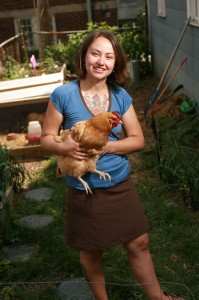"The ultimate goal of farming is not the growing of crops, but the cultivation and perfection of human beings." Masanobu Fukuoka So began the talk 'Home-Scale Ecological Food Production' by David Jacke on Friday July 30, 2010. Organized by the Ohio Ecological Food and Farming Association, the Clintonville presentation was attended by approximately 70 people.
Jacke, an expert in edible forest gardens and author of a set of books of the same name, continued by explaining that edible forest gardening is a new way of seeing, thinking, and acting in the world. Humans become co-creators and equal participants in the natural ecosystem.
What is a Forest Garden?
A forest garden mimics the forest as a design metaphor. It's a consciously designed ecosystem of perennial polycultures, i.e. groups of diverse species that come back year after year. Each plant has a 3-3000 year lifespan and contributes at least three of the following uses: food, fuel, fiber, fodder, fertilizer, f(ph)armaceutical and fun.
Forest garden plants have ecological functions as soil improvers (such as nitrogen fixers like beans), accumulators soaking up nutrients from deep soil (such as comfrey), or control of the environment (such as ground covers that prevent 'weeds'). Another class of plants provide important food and habitat to beneficial organisms such as pollinating bees. These include asters, umbels, and mints.
Coppice and Pollard
Plants may contribute to food, fuel, fiber, and fertilizer through coppicing and pollarding. Coppice is the new growth from a short stump after cutting. This cutting practice results in many small diameter sticks harvested every few years and a thick hedge like plant in the ground.
Pollard is new growth from a tall stump after cutting. In this practice, the results are a tall trunk barren of branches with a plethora of branches high in the ground, such as in a grazing field or around overground wires.
The byproducts of coppicing and pollarding, usually thin branches, can be used to fertilize, as animal fodder, as mushroom substrates, or as a material for garden furniture, tool handles, fences, and much more.
Mimicing Ecosystems
Plants gain adaptive advantage when they show emergent properties, that is characteristics that come about because of the interactions of components. Forest gardening is a case where the whole functioning together equals more than the sum of the individual parts. Ecosystems that mimic the forest are: resilient, self-maintaining, self-regulating, self-renewing, they produce clean air and water, and increase water storage and biodiversity overtime.
There is, necessarily, a nature-agriculture continuum. Organic agriculture is moving agriculture towards nature but still reliant on monoculture and inputs. Forest gardening is making nature more food productive.
Edible Gardening Goals
Edible forest gardens aim towards different goals than traditional or organic agriculture. Forest gardens hope to achieve:
- high diverse yields
- maximum self-maintenance
- maximum ecological health
- improve economic stability
- cultivate and embody a new paradigm: humans are nature and co-creative participants in nature
History
Edible forest gardening has been practiced in Africa, Asia, and Latin America since at least 1000 AD. Robert Hart creative the first modern western temperate forest garden in 1984 in England. Jacke shared about visiting Hart's garden. The loveliness of it actually brought tears to his eyes.
And yet, Hart made every mistake in design in the book. His patches were unorganized, making harvest difficult. Pathways were nonexistent, so visitors were constantly trampling plants. Some partner plants were not complimentary.
Design Principles
From observing Hunt's garden and studying others, Jacke has devised several principles of creating emergent properties. These are architecture, social structure, self-renewing fertility, and succession. Each concept is detailed further in the Edible Forest Gardens book.
Gardeners need to learn how to pack plants into patches and habitats with minimal competitive exclusion. Jacke emphasized several times how important it is to study and understand plants before including them in design.
Species niches are the inherent functions of a species including all interactions between an organism and its environment. The best designs include species that employ more than one function, ideally at least three.
Plant Guilds
Groups of species that perform a similar function in the community are known as guilds. Ideally each plant will occupy several guilds within the patch.
You might design with resource partitioning guild in mind, that is plants side by side that share a resource well. In example of this, Jacke showed a resource partitioning guild of plants that have differing root systems to effectively share shallow and deep sources of water. In the home garden, one might plant chinkapin, a chestnut bearing shrub with tap roots, next to juneberry or serviceberry, fruit bearing flat rooted species.
A mutual support guild is composed of species whose inherent yields supply another species' inherent needs. One might plant wild blue indigo, a nitrogen fixing perennial, near fruit bearing pear trees, who need nitrogen to produce.
The proverbial 'Three Sisters' plantings of corn, squash, and beans work because the species compliment each other in several guilds. Jacke suggested one could make a perennial Three Sisters by planting Jerusalem artichoke aka sunchoke heliantus tuberosa with groundnut apios americana and Chinese artichoke aka mint root stacchys affinis.
A World With Edible Forest Gardens
Surrounded by plant webs of support, stability, and harmony, edible forest gardeners do less work, waste less, and reduce stress to themselves and the environment. Jacke posits that a community rich in such gardens would be a society full of well fed, healthy, stable people. He concluded "Live in the garden and the garden lives in you."
David Jacke is repeating this public talk this Monday August 9 from 7:30 - 9 pm at the Glen Helen building in Yellow Springs Ohio. He will also be speaking on 'Soil Ecology and Self-Renewing Fertility' on Wednesday August 11 from 7:30 - 9 pm at the same location. All presentations are organized and supported by the Ohio Ecological Food and Farming Association.
More information about David Jacke and his book Edible Forest Gardens are available at his website. The site includes some very useful Resources for Forest Gardeners.











 I am excited to offer four summer day camps for kids who love to cook and eat!
Each camp will be an extended edition of the weekly Kids Cook series. In an open, creative environment, kids will taste and reflect on local healthy foods. All the senses will be engaged through story, hands on cooking, and art.
I am excited to offer four summer day camps for kids who love to cook and eat!
Each camp will be an extended edition of the weekly Kids Cook series. In an open, creative environment, kids will taste and reflect on local healthy foods. All the senses will be engaged through story, hands on cooking, and art.
